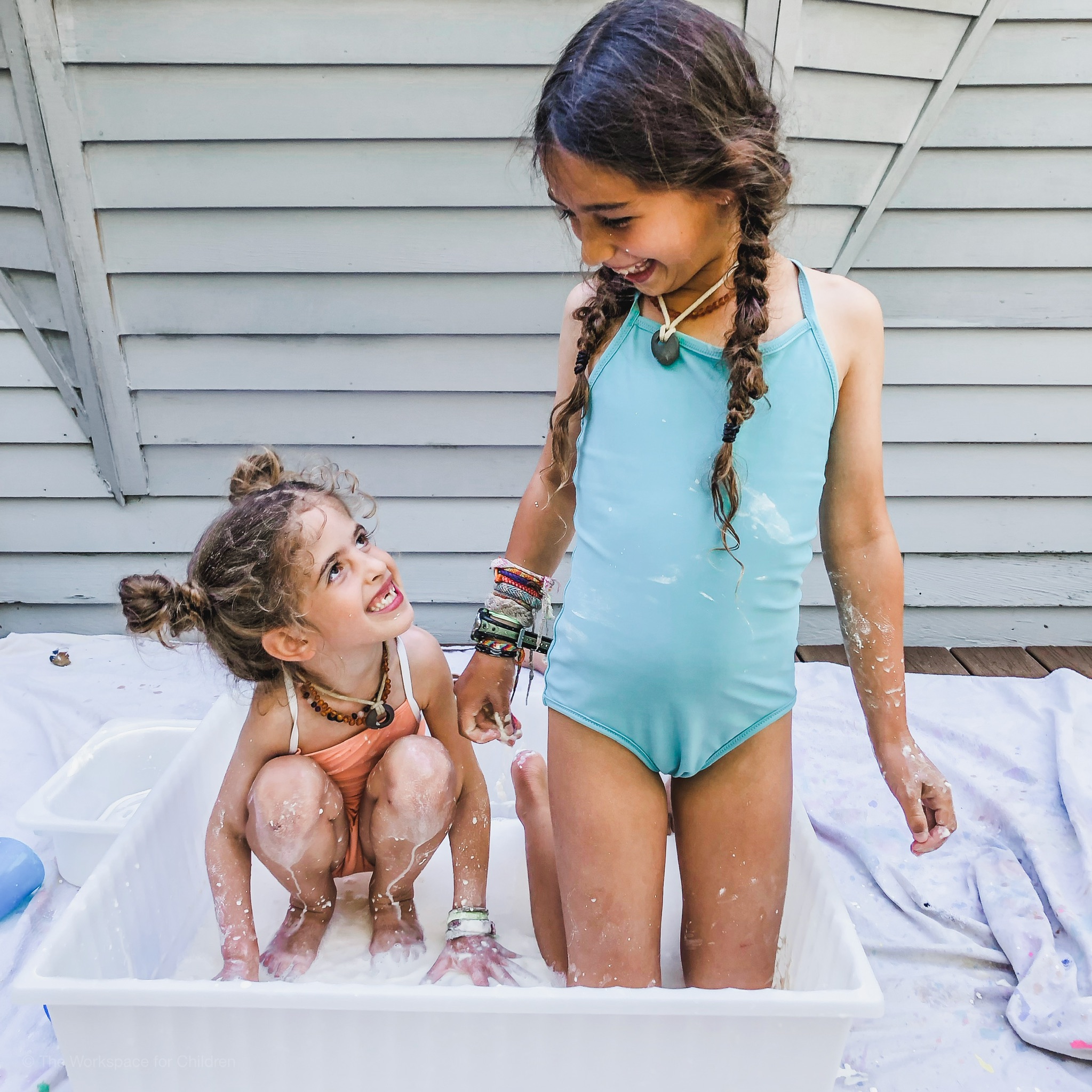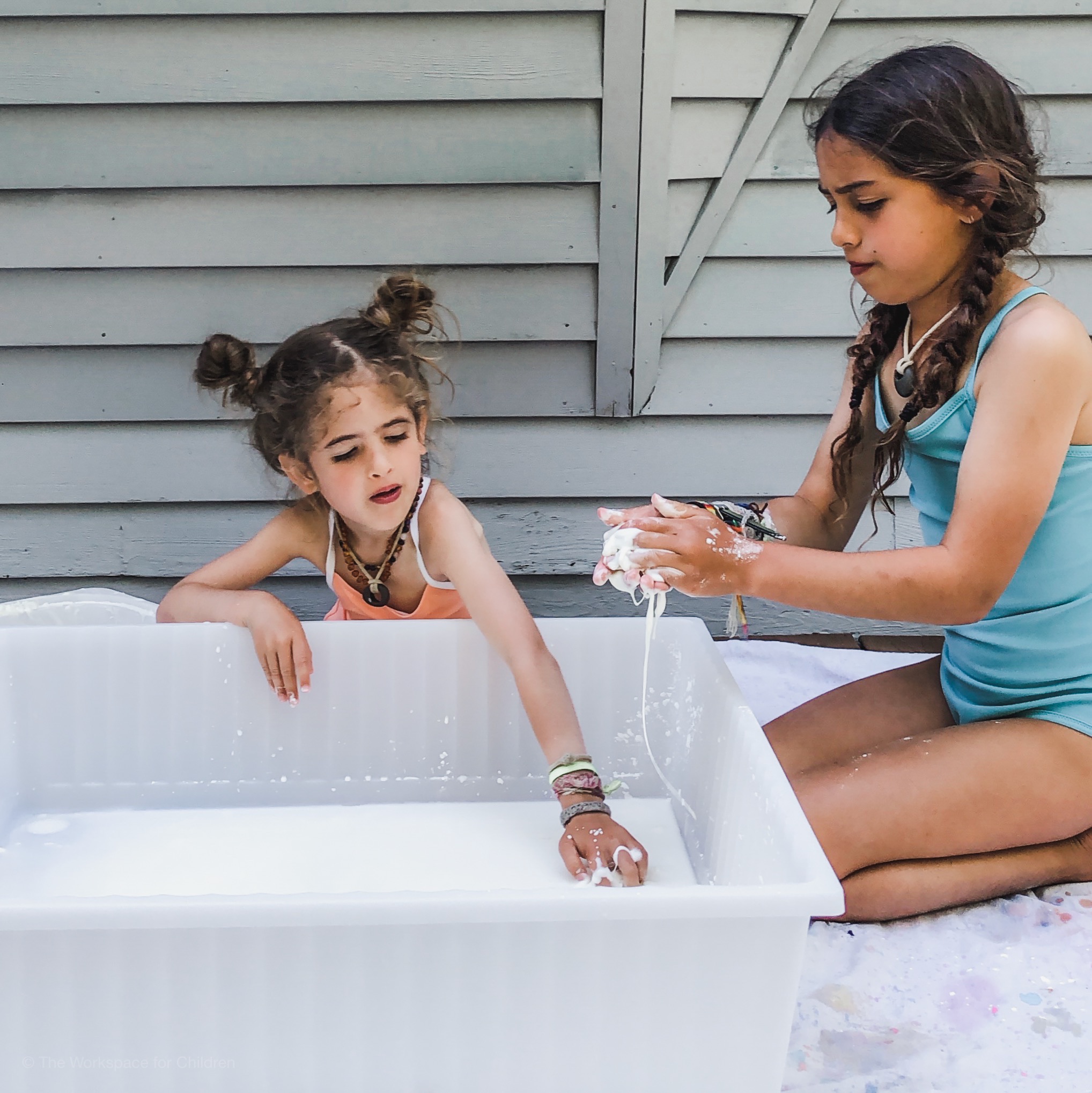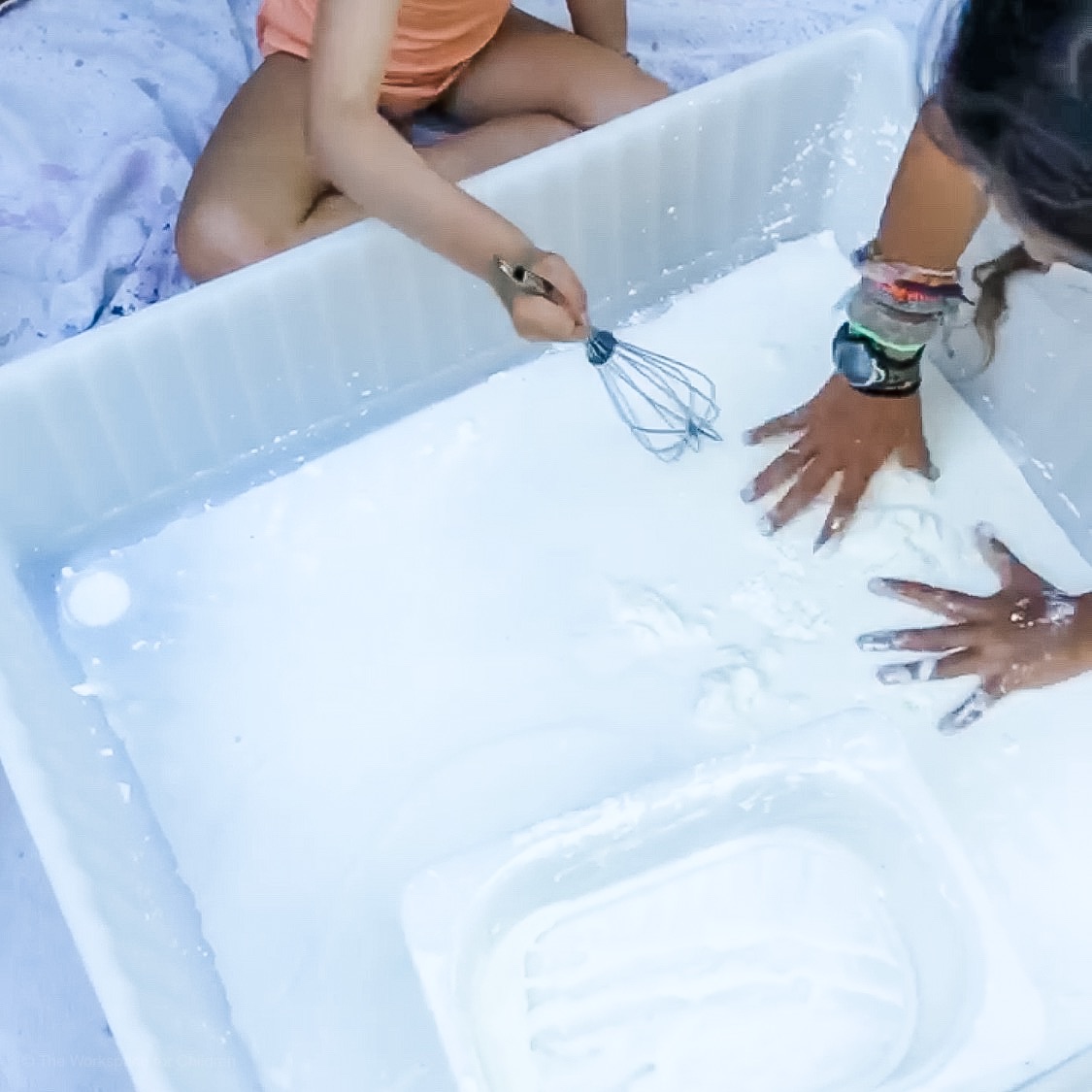CORNSTARCH AND WATER FOR EASY SENSORY PLAY
/Oobleck, Gak or Slime?
Today I am sharing another simple sensory activity that can entertain your baby, your preschooler, and even all those big cousins! It is very inexpensive, taste-safe, and chock full of learning potential. You likely have everything you need already in your pantry. Worried about the mess? Don’t be. You can hose everything down when you are finished… including the kids.
All you need is cornstarch and water, some bins or bowls, a water source, and your basic kitchen utensils.
Some people call this Oobleck, Gak, or Slime! We just call it FUN and EASY.
cornstarch and water make oobleck!
First, I am sharing how my nine and six year old explored and then I will share how you can adapt this activity for babies, and other way to adapt it for children who might feel intimidated by the goopy texture.
Ingredients:
Corn Starch and Water
Instructions:
You can mix this up in advance or allow your children to do it themselves. Provide one part water for two parts cornstarch. I love to make TONS and the children get so much joy out of mixing up a huge batch of this goopy, drippy mixture. Feel free to add a few drops of coloring, but I really like to keep things simple and natural and typically go without the coloring.
Before the children came home from camp, I placed out this huge drop cloth on the deck in the shade. I put our favorite Ikea GIMSE box down with a pitcher of pre-measured water and cornstarch. I wanted to give the kids the freedom to dump and mix without worrying that it wouldn’t turn out right. In retrospect, it wouldn’t have really mattered. Children rarely care about the outcome in these scenarios.
simple easy sensory play
I am perfectly okay with the children physically getting into the mixture. I love when they have the opportunity for a whole-body sensory experience, which is why I put out the giant bin. If you don’t want it all over them, try smaller bowl and bins on top of a low table or bench. If it is on the floor, you can be pretty sure your kids will find a way to get in the bin.
My girls dumped and mixed the water and cornstarch and stayed outside the bin at first. They relished in the fact that Oobleck is not a true liquid or a true solid. When you squeeze it or roll it quickly, it is solid. When you loosen your grip, it drips like a liquid. They experimented with a whisk, and also tried out different cups and spoons for scraping it from the bottom of the bin. After about fifteen minutes. my little one looked at me and asked if she could climb in. Guess what I told her?
The girls took turns dripping it over their feet and legs and then played salon and gave one another massages and pedicures with the goop. Eventually, their scooters beckoned from the driveway and they popped out and started to run away.
Clean Up Time:
HOLD UP!! Remember, we are at the beach for the summer and this is not our house. I am much more reigned in when it comes to mess at my in-law’s beach house. We got out the hose, and moved everything into the grass. I hosed down the girls and then they hosed down the bins and buckets and left them in the sun to dry. Drop cloth got rolled up for another day. Within minutes, everything was cleaned up and they were happily scootering in the driveway.
oobleck, gak, slime!
What if you don’t have an outdoor space with a hose and you are doing this activity in your apartment?
No worries. You can scrape the Oobleck right into the garbage can and shower everyone and everything off. This is an activity that is great indoors or out.
How to adapt this activity for a baby:
If my baby were sitting up unsupported, I would go for it! Obviously, mix the Oobleck up yourself and put a small amount on a tray in front of her. You could even do this in a high chair if you wanted, but I prefer to allow the baby to explore in an unrestricted manner. I would put down a drop cloth and a big oil drip tray. The lip will contain the ooze, but is still shallow enough for the baby to get in there. Bonus points if you set this up in front of the mirror. It is so wonderful for her developing sense of self if you allow your little one to see herself as she explores!
Language Prompts:
Child: What do I do?
Adult: Hmmm, I wonder…
Child pokes at the substance and looks at you. You resist the urge to point out the science of what is happening. I know that might sound counterintuitive, but hold your tongue. Allowing the child his own discovery and then supporting that is much more valuable than pointing it out yourself.
Child: It is cold and drippy.
Adult: It IS cold and drippy.
Child: I can’t pick it up. It’s stuck on the bottom.
Adult: You can’t pick it up? It’s stuck? Hmmm, I wonder if you’ll keep trying with just your fingers or if you want to try this spoon?
Child: Hey, I got some! Look! It’s dripping iff the spoon!! It is so goopy!
Adult: Oh wow, it really is dripping. A moment ago it was hard and stuck on the bottom of the bin.
Follow your child’s lead. Allow them to explore this new substance at their own pace. This is one of those activities you can repeat over and over the course of days and months. As the children begin to master the experience, they will learn and experiment with new aspects. This simple goop can provide so much learning.
What is my child getting from this experience?
Your child is practicing new language, she is making predictions and figuring out the outcome. He is observing and experimenting with the properties of liquids and solids. You kiddo is taking risks with a new material and learning how to manipulate it. She is measuring, scooping and practicing important fine motor skills that will later help her with pencil grip and writing. Most importantly, your child will be guiding his or her own play according to their own interests.
As your child grows and becomes more comfortable, you can add little figures to the goop. Try adding ice cubes or sprinkling some flower petals in. Add a pitcher or even an elevated shelf above the bin and let them watch how the goop reacts when poured from a higher surface.
Older children, even upper grade schoolers love this kind of sensory play. As children ages into the older grades in school their opportunities for self-directed learning drop dramatically. They are ALWAYS being told what to do and how to do it. I bet if this activity was out for your littles, and a big kids wandered by, they’d be ALL over it.
How to adapt this activity for a hesitant child:
What is your child doesn’t like the feeling of mess? What if she worries about getting her hands dirty? First of all, do not worry. This is a very common developmental stage that many children go through. One way to encourage them is by offering them a long handled spoon and an opportunity to use oobleck without other children around. This allows them a larger modicum of control in which to interact with the material. Also, I would suggest keeping a clean damp cloth or sponge nearby. Show him that he can wipe himself clean as often as he feels comfortable. Finally, do not force your child. You can allow the opportunity for this kind of play, but you don’t have to force them to engage.
Looking for more SENSORY PLAY IDEAS?
SENSORY ICE PLAY
RAINBOW RICE- HOW TO MAKE IT AND WHY YOU SHOULD
I hope you found this post helpful. If you want to hear more from me, please be sure to subscribe to my blog and join the conversation over on Instagram. -Lizzie
QUIET TIME AND INDEPENDENT PLAY EBOOK
This downloadable ebook is your personal guide to Quiet Time and Independent Play. This ebook will teach you the basic steps to implementing a Quiet Time and Independent Play strategy that works. The guide teaches you my proven 5 step method for implementing a daily break without using screens. (Guide includes 5 bonus invitations to play.)
THE PLAY PLAN
The Play Plan is an ebook containing play invitations that are easy to set up, inexpensive, and apply children of all ages. The 25 play prompts are divided into five categories and use items that you most likely already have at home. These play prompts consider children of all ages, all developmental stages, and all learning capabilities. Each prompt can be tailored to fit your unique child’s needs. Play is meant to be simple.











Ultimate Mother's Day Gift Guide: I’ve curated the perfect gift guide for any special woman in your life!